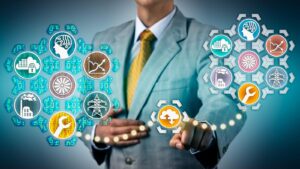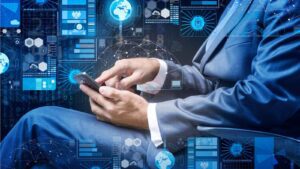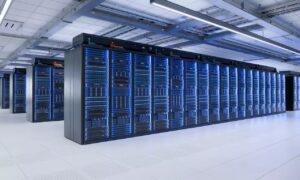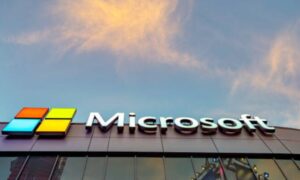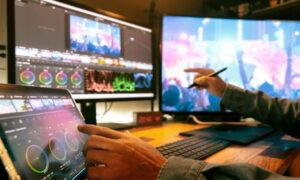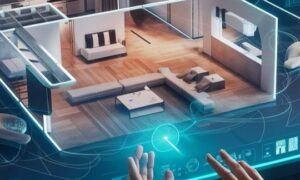Digital twins are turning the physical, digital…
Digital twin technology is being used in a myriad of different ways through a variety of industries to some amazing effects. The actual term ‘Digital Twin’ was first coined at the University of Michigan by author Michael Grieves during his research into product lifecycle management, but the concept has actually been flirting with advancing technology for decades. NASA even used a form of digital modelling for real world issues for its space missions – notably on the Apollo 13 mission. Key to the rescue mission of this doomed flight was the fact that NASA managed to recreate a digital twin model of Apollo 13 in the command centre that allowed engineers and space scientists to test all possible and improbable solutions from earth. (You may remember the very tense bit at Houston in the iconic 1995 film – “failure is not an option!”)
But Tom Hanks aside, let’s start with a simple question: what exactly is a digital twin? A digital twin is a virtual representation of a system or set of objects. The technology behind digital twins is designed to accurately reflect your system’s lifecycle and application, and uses a mix of machine learning, simulation and AI to help model uses, problems or efficiencies before anything is run in real life.
Essentially, a digital twin allows you to test out every conceivable scenario for your processes, products or physical facilities before hitting the big green button to launch. For data centre industries in particular, digital twin technology has transformed many everyday pain points – all the way from how vital cooling processes are managed to how data centre architecture is formed.
Where Else is Digital Twin Technology Being Used?
Outside of data centres, companies from different industries around the world are adopting digital twin systems to improve everything from processes to supply chain management, and from facilities management to meeting energy and sustainability targets. Whether in healthcare, the energy sector or manufacturing, digital twins are fast becoming the go-to technology to improve operations and productivity.
So let’s have a look at some real-world applications, and how digital twins are broadening the horizons of these industries:
Energy Sector
There are multiple uses for digital twin solutions in the energy sector, and it’s particularly beneficial when looking at maintenance schedules, especially for large-scale power generation equipment that cannot be easily replaced or switched off for routine maintenance.
End-to-end usage of digital twins allows operators to model repairs, look at optimising production and try out more efficient designs with no equipment downtime.
Using wind turbine technology as a particular example: a turbine is equipped with sensors that relay data about different aspects of performance, such as energy output and weather conditions. This data can then be applied to a digital twin model and processed without disturbing operations, and the digital twin model can suggest changes that could potentially be made to make each individual turbine more efficient.
Manufacturing
A key area in which digital twins are transforming operation capabilities is in the very varied manufacturing sector.
For this example, we’ll look at the automotive industry. Car manufacturers in particular have really embraced this technology. In this industry, a digital twin takes the form of a virtual replica of an entire car – its software, electronics, mechanics and even the actual wheels-in-motion physical movement of a vehicle.
Digital twins have revolutionised the way that cars are produced. Each stage of the manufacturing of cars can be improved – from design and build of the cars themselves to the customer experience.
In the broader manufacturing industry, a digital twin can accurately detect pain points, identify energy losses and opportunities for energy savings and discover where overall production line performance can be improved.
Health Care and Medicine
It’s not only products that can be profiled through digital twin technologies – it’s also… you!
It might seem like something from Bladerunner, but across the multiple different faces of healthcare digital twins are transforming the way medical professionals can deliver world-beating medical care to their patients.
In medicine, a digital twin takes the form of a virtual ‘avatar’ of a biological function, an organ or even an entire patient. This digital twin then profiles a variety of health indicators to assist in surgery, treatment or diagnosis. Creating a digital twin of a patient allows practitioners to simulate entire procedures and different variables before reenacting them in real time. Practice makes perfect!
Data can also then be collected about different scenarios and be used as an educational and learning tool to influence new pioneering horizons across healthcare.
Digital Twins Transforming the Future of Data Centres
In a data centre environment, a digital twin is so much more than just a digital representation of a physical structure. In data centres, a digital twin is a powerful tool that allows you to take a virtual representation of all the dynamics of your facility and create a simulation of how each element will behave, in real time, under any operating scenario you can think of.
With the right implementation, a digital twin can bring invaluable benefits to your operations. Once you have your data, your virtual model can be used to study performance problems, pain points and generate all possible solutions and improvements – which can then be applied in a real world scenario with no down time, reduced risk and a tangible time and resource saving.


